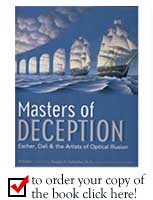First Annual Christmas Open House!
It’s time for some sphere-cheer!
On December 11th and 12th we will host THE FIRST ANNUAL CHRISTMAS OPEN HOUSE at the Termesphere Gallery from 9 to 4 pm. There will be a 10% discount on everything purchased during these two days at the gallery or on the Termespheres.com website. Our address is 1920 Christensen Drive, Spearfish South Dakota. Telephone for directions at 605-642-4805 if you don’t know the way. Christensen Drive is the road just west of K mart and we are 1.7 miles down the road.
Important note: If giving a Termesphere to everyone on your Christmas list is a bit out of reach this year, fear not! The Termesphere Gallery has lots of really cool, exceptionally unique gifts starting at $5.00.
Publications – Masters of Deception
by Al Seckel
The book I mentioned in the last newsletter is now on the shelves of Barnes and Noble, Borders Books and the Termesphere Gallery. MASTERS OF DECEPTION – ESCHER, DALI AND THE ARTISTS OF OPTICAL ILLUSION by Al Seckel is very exciting indeed. Amazon.com had this to say:
“Astonishing creations by masters of the art, such as Escher, Dali, and Archimbolo; amazing visual trickery; and an illuminating foreword by the Pulitzer Prize–winning author Douglas R. Hofstadter make this 320-page, breathtaking collection the definitive book of optical illusions.”
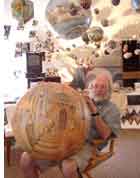 Two of my favorite artists, M.C. Escher and Salvador Dali are featured along with eighteen others including Giuseppe Arcimboldo, Jos De Mey, Rob Gonsalves, Scott Kim, Octavio Ocampo, Istvan Orosz, John Pugh, Roger Shepard and Yours Truly (page 295-304). All are serious artists who love to play with illusions within their work. Each of us is featured in a ‘gallery’ (chapter) with incredible color reproductions of our works along with explanations of how our illusions weave within our art pieces. I think this is an outstanding book that has some of the most exciting illusion art found in the world and just fun to look at again and again.
Two of my favorite artists, M.C. Escher and Salvador Dali are featured along with eighteen others including Giuseppe Arcimboldo, Jos De Mey, Rob Gonsalves, Scott Kim, Octavio Ocampo, Istvan Orosz, John Pugh, Roger Shepard and Yours Truly (page 295-304). All are serious artists who love to play with illusions within their work. Each of us is featured in a ‘gallery’ (chapter) with incredible color reproductions of our works along with explanations of how our illusions weave within our art pieces. I think this is an outstanding book that has some of the most exciting illusion art found in the world and just fun to look at again and again.
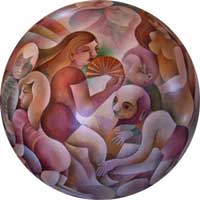 Termespheres (some new, some historic) and the thoughts behind them
Termespheres (some new, some historic) and the thoughts behind them
Each newsletter I like to explain one of my completed paintings. This time I would like to explain a little about the sphere ATOM AND EVE painted in 2002. This is a painting which combines science and religion. The science is the circular geometry which became the substructure for the painting. The circles that covered the whole sphere grew from a polyhedron that was first drawn on the sphere. I wanted the images that I invented from these circles to become the Adam and Eve story. The snake does this very well and also the apple and the tree. If you follow the snake it uses the tight fitting circles. Some of the circle grid or substructure is inside the snake and some of the circles are outside the snake. Even if people don’t see the circle substructure they feel the design WORKS. I would rather people didn’t know the strong circle grid was even there. The fear of the white canvas that artists talk about comes into play here, instead of making a scribble like some artist do, my scribble is a precise grid. This really gets my creative mind working and also give me back some results that I don’t expect.
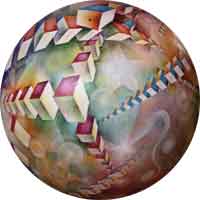 Recent Work
Recent Work
I finished BRAIN STRAIN! Last time I explained a little about this 30 point perspective spherical painting. The substructure for this sphere came from what Plato called the “Universe Polyhedron,” the dodecahedron. Each vanishing point I used is found in the center of the edges of the pentagons on the dodecahedron. There are twelve pentagons on this polyhedron. I used six equal distance points for my six-point perspective. By using the dodecahedron edges I was able to have five sets of cubical patterns, each having their own six point system, all happeing in the same sphere. So this comes to 30 point perspective. When I began this concept I thought it would look disorderly but with the dodecahedron substructure it seems to hold together very well.
The colors for this piece were much more intense than most of my paintings. I started with an almost pure palette as I wanted each of the set of six points to have its own color. I also wanted the cubes that projected to these points to be the same color. This helps people see the order. Most of the colors inbetween these vanishing points were mixtures of those pure colors. I used an orange, blue, green, red violet, and blue violet for the five colors. I used a glazing and stippling technique to do the painting. I also allowed myself to use white to mix in for some scumbling (using white as a thin wash) effects to help with better depth effects.
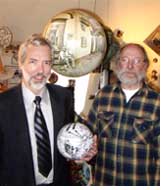 Works Sold
Works Sold
INSPIRATIONS FOR ESCHER sold to James R. Von Ehr II last month. Among his long list of amazing accomplishments, Von Ehr owns the largest collection of M.C. Escher in the world. It was an honor to meet him at the School of Mines and Technology in Rapid City where he gave the keynote speech at the Nanotechnology Conference which focused on the place of nanotechnology in science and society.
There is so much good to say about Mr. Von Ehr. He founded Altsys Fontographer in 1984 and sold it to Macromedia 1995 (an accomplishment that has my webmaster in awe). In June 2003 he was awarded Ernst & Young’s Entrepreneur of the Year Award for Pioneering and now he intends to get in on the ground floor of a second revolution – nanotechnology though his current company, Zyvex Corporation. He’s surrounded himself with the most prominent thinkers and researchers in the field, hoping to develop and sell the machines which will make nanotechnology as common as desktop computers are today. And now, he owns a Termesphere—which goes to show that along with his polished skills as a business man, scientist, innovator and social leader, he also has mighty fine taste in art.
IN THE WORKS -Mount Marty has committed to a commissioned sphere of their library environment and images of Mount Marty.
Works in Progress
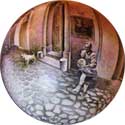 I have just finished a 15 piece one man show at Mount Marty College in the Bege Art Gallery of the Student Union in Yankton South Dakota. It was there until November 25th. While in Yankton I did a slide lecture at Yankton High School for the student body.
I have just finished a 15 piece one man show at Mount Marty College in the Bege Art Gallery of the Student Union in Yankton South Dakota. It was there until November 25th. While in Yankton I did a slide lecture at Yankton High School for the student body.
I traveled then to Augustana College in Sioux Falls and did a workshop on ONE THROUGH SIX POINT PERSPECTIVE. This two-hour session included students and instructors so it was great fun. It is always interesting to really make the art students think. I have put so much thinking into this workshop that it is fun for me to share the thinking with a captive audience. They tell me I give them a Termesphere headache.
The Tweed Museum of Art at the University of Minnesota, Duluth is touring a show called Mathematical Instinct. One of my Termespheres called FINISHING AN ESCHER is part of this traveling show. It also is being shown at Rutgers University in Camden NJ and the University Art Museum, University of Richmond VA. Sometimes your art work takes on a personality of its own and travels with its own story to tell.
Future Shows and Workshops
- February, 2005 – For the third year I will be doing a week long workshop for CREATIVE CONNECTIONS which consists of 150 Fine Art High School students from the DODDs system. It will take place in Oberwesel, Germany.
- April 28-9, 2005 -I will be one of the instructors at the ALL DAKOTA HIGH SCHOOL EXHIBITION and WORKSHOP, Groton, SD.
- June, 2005 – Termespheres One-man-show at Black Hills State University, Spearfish, SD.
- July 31- August 3, 2005 a showing Termespheres at Renaissance Banff (Canada) Bridges conference plus Coxeter Day.
- July 25th- January 6th One Man Show in stairwell at Washington Pavilion in Sioux Falls SD
SHOWS BEING WORKED ON….
- Iowa State showing at the Octagon Gallery
- Showing of Spheres at Cam-plex Gallery in Gillette, Wyoming
- South Dakota Art Museum in Brookings South Dakota
“IDEA” is how I make my living—Dick Termes
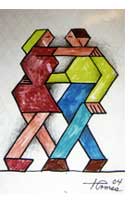 Dick’s Works in Progress
Dick’s Works in Progress
I am working on a spherical painting, which may be titled, OUT OF THE TRIANGLES, that plays with tessellating patterns. Tessellating patterns are patterns which fit tightly with themselves with no background space left over. The basic element I am exploring in this case is the triangle. The triangle as an element, has many different tessellating shapes that can be created from it. Some examples that come out of the triangle are the diamond, the chevron pattern and the hexagon, all can fit with themselves like tiling with no background spaces. A flat painting called COMMON DESCENT that I painted in 1972 made me think about what would happen if I played with this triangular grid on the sphere. This study of triangles led me to see how many interesting human figures might come out (be created) of this grid. I am very pleased with them. It’s as if they are creating themselves. They definitely make the painting OUT OF TRIANGLES into an extremely dynamic piece. As I progress, the tessellation will create the land, mountains and sky, indeed the entire environment the human forms live in.
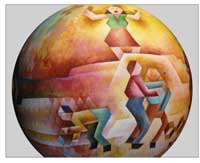 One of the things Escher taught me is geometry or pure optical illusion alone can come off too math-like. Many people don’t relate to this type of study. If this same geometric world is also a landscape with people living in it, it becomes something people can relate to. The study will get to the viewer by osmosis as they look at the painting. I am very much enjoying painting this piece, which has to be a good sign.
One of the things Escher taught me is geometry or pure optical illusion alone can come off too math-like. Many people don’t relate to this type of study. If this same geometric world is also a landscape with people living in it, it becomes something people can relate to. The study will get to the viewer by osmosis as they look at the painting. I am very much enjoying painting this piece, which has to be a good sign.
Another smaller sphere I have been working on was inspired by Jeff Weeks who is an expert in Topology and Geometry Software. Doris Schattschneide who wrote the book VISIONS OF SYMMETRY suggested I talk to him about tessellations. He suggested a variation on my ARROW SPHERE which has tessellations or tight fitting arrows going both directions to two different poles on a sphere. His idea was to bring the arrow out of one point and bring them back in to the same point. He says this idea is like the way the magnetic energy patterns works. I tried this and it is a pretty exciting little sphere. It is still in process.
End Note
The first newsletter had the thought or question,
“WAS SIX POINT PERSPECTIVE DISCOVERED OR FOUND (INVENTED)?”
I am going to change these words to DISCOVERED OR INVENTED to help make this thought more clear.
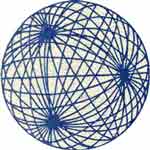 Bill Fleming, friend and fellow artist, suggested he wanted to hear my answer to that question. So this one is for you Bill.
Bill Fleming, friend and fellow artist, suggested he wanted to hear my answer to that question. So this one is for you Bill.
First I want to make a distinction between the two words. The kind of “discovered” I mean is when it was always there and you just have to realize it. The kind of “invented” is not to uncover but rather to make up without the help of nature.
I have a little trouble saying that the six point perspective concept was INVENTED when I also tell everyone it is right out there for us to see. It is hard to say I invented it when it is right in front of us. One could say, if I am the only one that could see it, than it would be INVENTED. I feel, I looked out there and FOUND it. It was waiting for me to imagine myself crawling inside a transparent sphere and copy what I saw onto the sphere. When I envision myself inside my stable transparent ball which is inside a cubical building and I turn in a circle, the three sets of parallel lines which make up the cubical room are right around me. There is a set of lines that run north and south, another set that runs east and west and another set that runs up and down. If 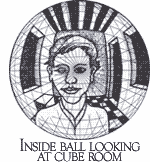 I follow the lines they lead me to the six vanishing points. The lines that I am following are not straight lines but rather curved lines or they wouldn’t be able to go to all six points. Later I realized that there is another way the six points could be found–if I figured out the closest point between me on the four wall and the ceiling and the floor. If I measured with a measuring tape from my eyes to the six planes, the closest point to the walls shows me where the vanishing points are located. Once I think of myself inside my transparent sphere and see how images from the outside room would project to the skin of the sphere this became clear. I guess what I am saying is that I believe I discoverd it rather than invented it. Inventing seem more like I made it up and I don’t believe this is made up. I think this is how it really is. Let me know what you think.
I follow the lines they lead me to the six vanishing points. The lines that I am following are not straight lines but rather curved lines or they wouldn’t be able to go to all six points. Later I realized that there is another way the six points could be found–if I figured out the closest point between me on the four wall and the ceiling and the floor. If I measured with a measuring tape from my eyes to the six planes, the closest point to the walls shows me where the vanishing points are located. Once I think of myself inside my transparent sphere and see how images from the outside room would project to the skin of the sphere this became clear. I guess what I am saying is that I believe I discoverd it rather than invented it. Inventing seem more like I made it up and I don’t believe this is made up. I think this is how it really is. Let me know what you think.
Thank you for reading to the end. I hope some of my thoughts will get some comments back from you, positive or negative and, new ideas. I love the way some of my math friends are making suggestions of concepts for me to consider. If you would like to be taken off this newsletter list please let me know. As always, thank you for your tremendous support and encouragement. I would love to hear what you think.
Feel free to call at 888-642-4805 or email me termes@blackhills.com
